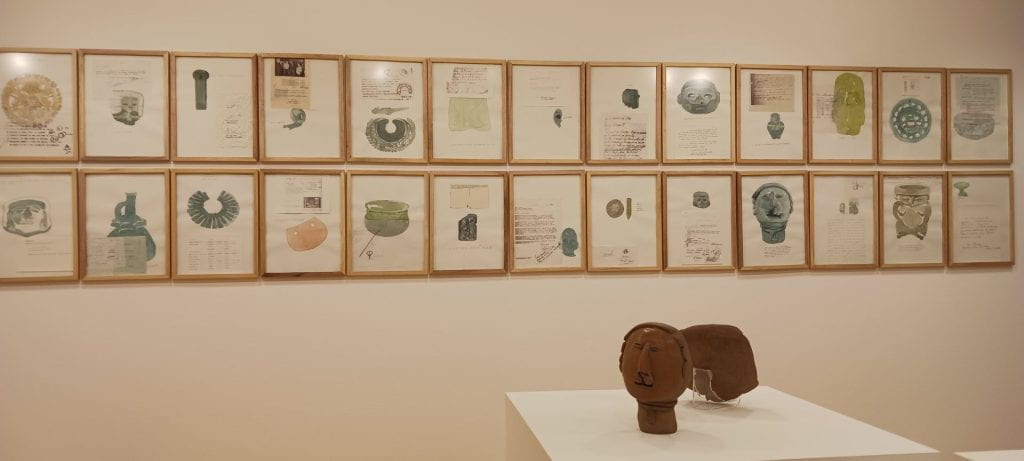In 2023, Dr. John Pierce from Tucson, Arizona placed in the care of Ohio State’s Kawsay Ukhunchay Andean and Amazonian Indigenous Art and Cultural Artifacts Research Collection a series of six paintings by Hipolito Mamani, the son of a second-order healer (curandero) from Cuzco, Peru. Mamani said the paintings represented his father’s visions of ancestors who return every 100 years. Mamani called the paintings his “children.”

Undergraduate student, Cassilyn Blair (class of 2023), took on the challenge of researching this artist for a class on Andean Art, Culture and Society, and this spring, drawing on Cassie’s insights, student researchers for the Kawsay Ukhunchay Andean and Amazonian Indigenous Art and Cultural Artifacts Research Collection installed these paintings in the Department of Spanish and Portuguese main office in Hagerty Hall 298.

Camay, an Andean Quechua verb that signals “something infused with energy” helps us to grasp this concept of living art as a relationally interconnected entity and to understand why Mamani considers these art pieces his children. They are living beings brought into presence through creation.
Born in the district of Pablo-Sichuan, Peru, Hipolito Mamani traveled as a teenager to Cusco to study painting at the Escuela Regional de Bellas Artes Diego Quispe Tito. Various techniques in Mamani’s art connect his work back to pre-Columbian Andean styles and to shamanism and shamanic art, replete with multivalent imagery, recurrent themes, and repeating motifs (Stone, The Jaguar Within, 2012, pg. 53). Some of the motifs include rainbows and sacred birds, like macaws, hummingbirds and owls, all of which act as messengers between the human and spiritual realms. The amaru (mythic anaconda) and felines such as jaguars are also recurring themes in Andean art.

Although Hipolito Mamani is a contemporary artist, he has an obscure online footprint, which made Cassie’s research all the more challenging. Information for this exhibition draws on Blair’s important research and unique vision as an artist herself.
Based on her own shapeshifting art, Cassie envisioned this installation with use of LED color transition lights to demonstrate and enhance the transitory aspect of Mamani’s images. Mamani’s paintings have a multidimensional essence, meaning rotating the paintings or observing them under different light can alter the viewer’s perception of the images. Different colors and aspects of each painting stand out depending on the color of the lighting, creating a transformational piece with concealed meaning and hidden coding. The more you look, and most importantly, the different ways you look, the more you see.

The installation process involved adopting Blair’s research and unique vision to highlight the painting’s multivalent style.
Feel free to stop by Hagerty Hall 298 to see these stunning paintings!
















 We welcome Kareen Darwich as a new member of our team! She is a third-year undergraduate Health Sciences student, hoping to pursue dentistry. She comes from a science background and is eager to implement this into her undergraduate thesis. Upon joining the team, Kareen remarked upon the contrast between her structured courses in the hard sciences to the alternative learning and unlearning space of the Kawsay Ukhunchay collective. Her Spanish minor and this new dynamic influenced her to pursue work with the Andean and Amazonian Indigenous Art and Cultural Artifacts Research Collection.
We welcome Kareen Darwich as a new member of our team! She is a third-year undergraduate Health Sciences student, hoping to pursue dentistry. She comes from a science background and is eager to implement this into her undergraduate thesis. Upon joining the team, Kareen remarked upon the contrast between her structured courses in the hard sciences to the alternative learning and unlearning space of the Kawsay Ukhunchay collective. Her Spanish minor and this new dynamic influenced her to pursue work with the Andean and Amazonian Indigenous Art and Cultural Artifacts Research Collection.




